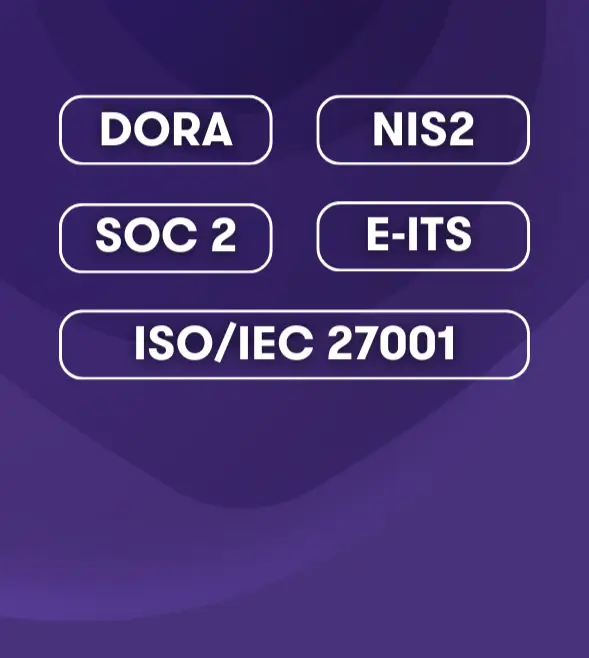-
Other audit services
We help clients with the application and use of foreign financial aid of EU and other funds and help prepare financial reports.
-
Audit calculator
The calculator will answer if the company's sales revenue, assets or number of employees exceed the limit of an inspection or audit.
-
Payroll and related services
We perform payroll accounting for companies whether they employ a few or hundreds of employees.
-
Tax accounting
Grant Thornton Baltic's experienced tax specialists support accountants and offer reasonable and practical solutions.
-
Reporting
We prepare annual reports in a timely manner. We help to prepare management reports and various mandatory reports.
-
Consolidation of financial statements
Our experienced accountants and advisors help you prepare consolidation tables and make the consolidation process more efficient.
-
Consultancy and temporary staff
Our experienced specialists advise on more complex accounting transactions, rectify poor historic accounting, and offer the temporary replacement of an accountant.
-
Outsourced CFO service
Our CFO service is suitable for companies of all sizes and in all industries. We offer services to our clients in the required amount and competences.
-
Assessment of accounting processes
We help companies to implement accounting practices that are in compliance with local and international standards.
-
Accounting services for small businesses
We offer affordable service for small businesses. We help organize processes as smartly and cost-effectively as possible.
-
Cryptocurrency accounting
We keep up with blockchain technology to serve and advise crypto companies. We are supported by a network of colleagues in 130 countries.
-
Trainings and seminars
Our accountants have experience in all matters related to accounting and reporting. We offer our clients professional training according to their needs.

-
Business advisory
We offer legal support to both start-ups and expanding companies, making sure that all legal steps are well thought out in detail.
-
Fintech advisory
Our specialists advise payment institutions, virtual currency service providers and financial institutions.
-
Corporate advisory
We advise on legal, tax and financial matters necessary for better management of the company's legal or organizational structure.
-
Transaction advisory
We provide advice in all aspects of the transaction process.
-
Legal due diligence
We thoroughly analyze the internal documents, legal relations, and business compliance of the company to be merged or acquired.
-
In-house lawyer service
The service is intended for entrepreneurs who are looking for a reliable partner to solve the company's day-to-day legal issues.
-
The contact person service
We offer a contact person service to Estonian companies with a board located abroad.
-
Training
We organize both public trainings and tailor made trainings ordered by clients on current legal and tax issues.
-
Whistleblower channel
At Grant Thornton Baltic, we believe that a well-designed and effective reporting channel is an efficient way of achieving trustworthiness.

-
Business model or strategy renewal
In order to be successful, every company, regardless of the size of the organization, must have a clear strategy, ie know where the whole team is heading.
-
Marketing and brand strategy; creation and updating of the client management system
We support you in updating your marketing and brand strategy and customer management system, so that you can adapt in this time of rapid changes.
-
Coaching and development support
A good organizational culture is like a trump card for a company. We guide you how to collect trump cards!
-
Digital services
Today, the question is not whether to digitize, but how to do it. We help you develop and implement smart digital solutions.
-
Sales organisation development
Our mission is to improve our customers' business results by choosing the right focuses and providing a clear and systematic path to a solution.
-
Business plan development
A good business plan is a guide and management tool for an entrepreneur, a source of information for financial institutions and potential investors to make financial decisions.
-
Due diligence
We perform due diligence so that investors can get a thorough overview of the company before the planned purchase transaction.
-
Mergers and acquisitions
We provide advice in all aspects of the transaction process.
-
Valuation services
We estimate the company's market value, asset value and other asset groups based on internationally accepted methodology.
-
Forensic expert services
Our experienced, nationally recognized forensic experts provide assessments in the economic and financial field.
-
Business plans and financial forecasts
The lack of planning and control of cash resources is the reason often given for the failure of many businesses. We help you prepare proper forecasts to reduce business risks.
-
Outsourced CFO service
Our CFO service is suitable for companies of all sizes and in all industries. We offer services to our clients in the required amount and competences.
-
Reorganization
Our experienced reorganizers offer ways to overcome the company's economic difficulties and restore liquidity in order to manage sustainably in the future.
-
Restructuring and reorganisation
We offer individual complete solutions for reorganizing the structure of companies.
-
Corporate taxation
We advise on all matters related to corporate taxation.
-
Value added tax and other indirect taxes
We have extensive knowledge in the field of VAT, excise duties and customs, both on the national and international level.
-
International taxation
We advise on foreign tax systems and international tax regulations, including the requirements of cross-border reporting.
-
Transfer pricing
We help plan and document all aspects of a company's transfer pricing strategy.
-
Taxation of transactions
We plan the tax consequences of a company's acquisition, transfer, refinancing, restructuring, and listing of bonds or shares.
-
Taxation of employees in cross-border operations
An employee of an Estonian company abroad and an employee of a foreign company in Estonia - we advise on tax rules.
-
Tax risk audit
We perform a risk audit that helps diagnose and limit tax risks and optimize tax obligations.
-
Representing the client in Tax Board
We prevent tax problems and ensure smooth communication with the Tax and Customs Board.
-
Taxation of private individuals
We advise individuals on personal income taxation issues and, represent the client in communication with the Tax and Customs Board.
-
Pan-Baltic tax system comparison
Our tax specialists have prepared a comparison of the tax systems of the Baltic countries regarding the taxation of companies and individuals.
-
Internal audit
We assist you in performing the internal audit function, performing internal audits and advisory work, evaluating governance, and conducting training.
-
Internal Audit in the Financial Services Sector
We provide internal audit services to financial sector companies. We can support the creation of an internal audit function already when applying for a sectoral activity license.
-
Audit of projects
We conduct audits of projects that have received European Union funds, state aid, foreign aid, or other grants.
-
Prevention of money laundering
We help to prepare a money laundering risk assessment and efficient anti-money laundering procedures, conduct internal audits and training.
-
Risk assessment and risk management
We advise you on conducting a risk assessment and setting up a risk management system.
-
Custom tasks
At the request of the client, we perform audits, inspections and analyzes with a specific purpose and scope.
-
External Quality Assessment of the Internal Audit Activity
We conduct an external evaluation of the quality of the internal audit or provide independent assurance on the self-assessment.
-
Whistleblowing and reporting misconduct
We can help build the whistleblowing system, from implementation, internal repairs and staff training to the creation of a reporting channel and case management.
-
Information security management
We provide you with an information security management service that will optimise resources, give you an overview of the security situation and ensure compliance with the legislation and standards.
-
Information security roadmap
We analyse your organisation to understand which standards or regulations apply to your activities, identify any gaps and make proposals to fix them.
-
Internal audit of information security
Our specialists help detect and correct information security deficiencies by verifying an organization's compliance with legislation and standards.
-
Third party management
Our specialists help reduce the risks associated with using services provided by third parties.
-
Information security training
We offer various training and awareness building programmes to ensure that all parties are well aware of the information security requirements, their responsibilities when choosing a service provider and their potential risks.
-
Digital Operational Resilience Act (DORA)
We will help you create a DORA implementation model that meets your company's needs and ensures that you meet the January 2025 deadline.

-
ESG advisory
We help solve issues related to the environment, social capital, employees, business model and good management practices.
-
ESG audit
Our auditors review and certify sustainability reports in line with international standards.
-
Sustainable investments
We help investors conduct analysis of companies they’re interested in, examining environmental topics, corporate social responsibility and good governance practices.
-
Sustainable tax behaviour
Our international taxation specialists define the concept of sustainable tax behaviour and offer services for sustainable tax practices.
-
ESG manager service
Your company doesn’t necessarily need an in-house ESG manager. This role can also be outsourced as a service.

-
Recruitment services – personnel search
We help fill positions in your company with competent and dedicated employees who help realize the company's strategic goals.
-
Recruitment support services
Support services help to determine whether the candidates match the company's expectations. The most used support services are candidate testing and evaluation.
-
Implementation of human resource management processes
We either assume a full control of the launch of processes related to HR management, or we are a supportive advisory partner for the HR manager.
-
Audit of HR management processes
We map the HR management processes and provide an overview of how to assess the health of the organization from the HR management perspective.
-
HR Documentation and Operating Model Advisory Services work
We support companies in setting up HR documentation and operational processes with a necessary quality.
-
Employee Surveys
We help to carry out goal-oriented and high-quality employee surveys. We analyse the results, make reports, and draw conclusions.
-
HR Management outsourcing
We offer both temporary and permanent/long-term HR manager services to companies.

-
Digital strategy
We help assess the digital maturity of your organization, create a strategy that matches your needs and capabilities, and develop key metrics.
-
Intelligent automation
We aid you in determining your business’ needs and opportunities, as well as model the business processes to provide the best user experience and efficiency.
-
Business Intelligence
Our team of experienced business analysts will help you get a grip on your data by mapping and structuring all the data available.
-
Cybersecurity
A proactive cyber strategy delivers you peace of mind, allowing you to focus on realising your company’s growth potential.
-
Innovation as a Service
On average, one in four projects fails and one in two needs changes. We help manage the innovation of your company's digital solutions!


Employer and employee enter into their employment contract as the outcome of pre-contractual negotiations on mutually agreed conditions. It’s under the employment contract that the employee submits to the employer’s direction and supervision. One of the most important conditions of the employment contract is the description of duties of employment. If the duties of employment are not clearly specified in the employment contract, they must definitely be listed in the job description. In fact, over time, the job description has become a more substantial document than merely a description of duties. In the job description, employers also set out aspects such as superior-subordinate relations, substitutes and the employee’s aptitude for the position, taking into account the employee’s development, aptitude, experience, and other important aspects. A clear and understandable description of duties of employment allows the employer to exercise their rights insofar as requiring the employee to perform the duties of employment agreed upon. At the same time, the employee also knows what functions they are expected to fulfil.
Don’t forget to register employment
On the first day of work, everything seems very run-of-the-mill – a new person is at work and can start performing their duties of employment. By the moment that the person starts work, the employer must register the commencement of employment in the register of employment (Estonian abbreviation: TÖR). Unfortunately there have been cases, especially among employers who are foreign nationals who are not aware of the requirement and the employment goes unregistered.
To register the commencement of employment, the employer must indicate the new employee’s personal identification code, or in its absence, the date of birth, start date – the day on which they began work under the employment contract, the type of work (a comprehensive table can be found on the Tax and Customs Board website), working time, title of the position and the address of the place of work.
Registration of commencement of employment is also extremely important from the employee’s standpoint, as only registered employees have health insurance. Entering data into the TÖR is the legal basis for insurance coverage to arise; the Tax and Customs Board forwards data from the TÖR to the Health Insurance Fund. Timely submission of data and registration of employment is of the utmost importance, as the health insurance starts after a 14 day have elapsed since the day of commencement of work entered into TÖR. If the employment start date entered into TÖR falls within a valid insurance coverage period, insurance will continue seamlessly. If the employer fails to register the employee for health insurance and the employee should have been entitled to receive healthcare compensation, the employer must compensate the employee for any health insurance compensation forgone. More information can be found on the Health Insurance Fund website.
Training and supervision are critical
If it’s an employee’s first day at work and the commencement of employment has been registered, the employer wants the employee to start work. Before that happens, the employer has one important to-do – a workstation must have been prepared for the employee based on the nature of the work, taking into account work safety and ergonomic specifics of the job. In other words, the employee must have appropriate and comfortable conditions to work in.
As the next step, the employer must brief the employee on occupational health and safety arrangements at the company. The employer may permit the employee to start work once it has been made certain that the employee knows the company’s occupational health and safety arrangements and is able to use safe working techniques in practice. For this purpose, every employee is required to introduce the employee to guidelines related to the working environment, which include, for example, general occupational health and safety guidelines, rules for organization of work, first aid giving and first aid kit user manual, procedure for employees’ medical examinations, if necessary guidelines for remote work and remote workers’ occupational health and safety instructions, among others. In the course of briefing the employee on these guidelines, the employer also organizes training, taking into account the specific nature of the work and its hazardousness, where applicable.
The employee masters the use of safe working techniques through successfully completing practical training. Ordinarily, the employer designates an experienced employee as the supervisor, who is responsible for training the new employee during a period of time specified by the employer. The duration of training depends on the specific nature and hazardousness of the work. It should be borne in mind that the training must also be held if the new employee has done similar work at another employer. Above all, this is because of the potentially different approaches, requirements, tools and work environments at different employers.
Supervision and training must be registered
Once the theoretical and practical supervision and training have been completed, the employer registers the date and content of the training in writing or in a form reproducible in writing. The employee is required to certify by signature that the employer has indeed instructed and trained them. Employers use different ways of registering the training, such as a spreadsheet or software with the necessary modules. The latter is a very convenient solution for larger companies, because completing and maintaining spreadsheets becomes inconvenient over time. The purpose of registering supervision and training is to ensure that the employer can, if necessary, prove that these have taken place; it also provides a better overview of whether all employees have received the corresponding supervision and training.
Nowadays, people tend to take good care of their health, which is also an important topic in employment relations. Employers are obliged to address the issue of employee health, by arranging a medical examination within four months of the hire date. The expenses of the examination are borne by the employer and the examination takes place during the employee’s working time. The employer-arranged medical examination is obligatory for employees and may not be refused since the requirement comes from the Occupational Health and Safety Act. Refusal to undergo medical examination may be grounds for termination of employment relationship.
Once the abovementioned activities are completed, you will successfully have completed the stages of hiring a new employee.
Grant Thornton Baltic’s specialists will be happy to provide advice in navigating the above stages and if desired, prepare the necessary documents needed for starting an employment relationship. Don’t hesitate to contact us to talk about your organization’s needs in more detail!
If you have similar challenges and questions, please contact our specialists.









